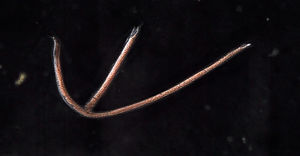|
Date & Time : 23, April 2024 12:10
General Characteristics of Platyhelminthes
Classification of Platyhelminthes
A Few Examples
1.Planaria dorotocephala
Common name- Dugesia
Habitat- freshwater species, found in ponds, lakes and springs.
Distribution- Cosmopolitan in distribution, found in India, Myanmar, U.K., U.S.A., and USSR.
IDENTIFYING CHARACTERS:--
- Body- Body is elongated, cylindrical and dorsoflattened.
- Body color- brown to black.
- Body division- It is divided into anterior head and posterior body.
- Head- It is triangular containing auricles (ear like) and eyes or ocelli (semicircular, one pair). Auricles and eyes both are sensory structures.
- Posterior body- it conmtains highly pointed end.
- Digestive system- complete, consisting of mouth, pharynx, proboscis and intestine (branched).
- Mouth- The mouth is situated in middle of the ventral surfaceand is surrounded by proboscis pore.
- Intestine- It has three branches in which one is extending upwards and other two are extending backwards.
- Genital pore- It is located posterior to the mouth.
- Reproduction- It reproduces sexually or asexually. Regeneration also occurs.
2. Taenia solium
Common Name- Pork tapeworm.
Habit and habitat- It is the parasite in the intestine of man.
Distribution- it is found in India, China, Yogoslavia, and Germany.
IDENTIFYING CHARACTERS:-
- Body- Body is about 4-5 meters in length.
- Segmentation- it consists of about 700-900 segments.
- Body division- It is differentiated intoscolex, neck and thenimmature, mature, gravid and malformed segments.
- Mature segments- They contain fully developed hermaphrodite genital organs.
- Scolex- It is adhesive in nature, consisting of four suckers and a rounded rostellum( surrounded by a double row of 28-32 hooks).
- Life cycle- Life cycle of T. solium isindirect. It requires an intermediate host pig for development.
- Diseases- It causes diseases like anaemia, secondary anaemia, eosinophilia, diarrhea, haemorrhage,abdominal pain and nausea etc.
3.Taenia saginata
Common name- Beef tapeworm.
Habit and habitat- It found in the posterior coils of the intestine.
Distribution- It found in India, China and Germany.
IDENTIFYING CHARACTERS;-
- Body- it is about 4-6 meters in length.
- Body color- whittish in color ( preserved).
- Body segments- Body is divided into about 1000 segments.
- Types of segments- There are four types of segments:-immature, mature, gravid and malformed segments.
- Body division- Body is divided into scolex, neck and strobila (segments).
- Scolex- It contain 4 suckers. But rostellum and hooks are absent.
- Life cycle- Life cycle is indirect. Buffalo is intermediate host.
- Diseases- It causes diarrhoea, nausea and insomnia and abdominal pain etc.
4.Fasciola hepatica
Common name- Sheep liver fluke.
Habit and habitat- It is a pathogenic parasite in the liver and bilary passage.
Distribution- Cosmopolitan distribution. It found in sheep raising areas like India, U.S.A., Cuba and Syria etc.
IDENTIFYING CHARACTERS:-
- Body- It has beef like and dorso-ventrally flattened body.
- Body length- 18-50 mm in length.
- Mouth- Mouth is small and ventrally situated at anterior extremity.
- Suckers- There are two types of suckers naming oral and ventral sucker.
- Oral sucker- It surrounds the mouth and located at the anterior extremity.
- Ventral sucker- It is also called acetabulum ( adhesive in nature) and is located a little behind to the mouth.
- Pores- gonopore and excretory pore.
(1)Gonopore is locatedbetween oral and ventral suckers
(2)Excretory pore is located at posterior extremity
- Cephalic cone- Anterior end consists of a conical projection. This is called cephalic cone.
- Hermaphrodite.
- Digestive system- It consists of mouth, oral sucker, pharynx, oesophagus and bifid intestine.
- Life cycle- Indirect and is completed in two hosts sheep and snail.
5.Catenula
IDENTIFYING CHARACTERS:-
- Digestive tract- consist of simple pharynx.
- Excretory system- consist of single protonephredia (median).
- Nervous system- 4 pairs of longitudinal nerve cords and a statocyst.
- Reproduction- asexual by transverse fission.
6.Convoluta
Habitat- exclusively marine form, lives under stones among algae.
IDENTIFYING CHARACTERS-
- Body is small and ventrally curved.
- Anterior end contain frontal glands (many in number), eyes (one pair), a single statocyst and mouth (ventrally situated).
- excretory system is absent.
7.Schistosoma

|